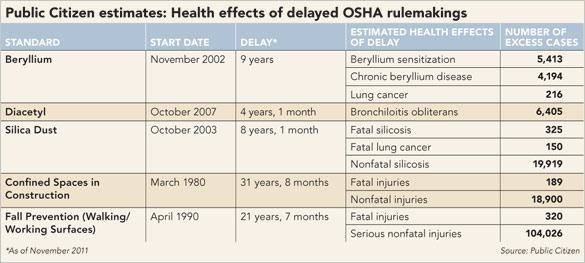‘Layers’ weigh down OSHA
What’s the cost of OSHA’s prolonged rulemaking process? According to one group, 100,000 serious injuries and 30,000 illnesses.
An October report from Public Citizen, a Washington-based nonprofit consumer rights organization, claims those injuries and illnesses – and hundreds of fatalities – could have been prevented if five proposed OSHA standards had not seen delays ranging from 4 to 31 years. (See table.)
During a media event on Nov. 1 at the 2011 National Safety Council Congress & Expo in Philadelphia, OSHA administrator David Michaels told reporters that the rulemaking process is similar to legislation: The agency must address a variety of stakeholders who all have different needs, and the end result is a compromise to reflect those needs.
“What we try to do is get a standard that will be effective and not be burdensome and not be too costly, but have a real, very positive impact,” Michaels said. “This process helps us get there, but unfortunately it is a very, very slow and complex process.”
In the last issue of S+H, I wrote about the various steps OSHA takes in crafting its standards (“Regulation 101,” December 2011, p. 38); Public Citizen’s report references the processes imposed on the agency by federal courts, the U.S. Congress and presidential administrations.
The added requirements from these three government branches also were addressed at the media event by NIOSH Director John Howard and Michael Silverstein, assistant director for industrial safety and health at the Washington State Department of Labor and Industries.
“Each branch of government has layered the [Occupational Safety and Health] Act, and so you can’t look at OSHA itself and say they’re responsible for how long it takes,” Howard said.
The question then becomes whether or not these new layers benefit the rulemaking process or if they are – as Public Citizen suggests in its report – a burden. According to Howard, literature on the subject implies both, but Silverstein was adamant that the process has been weighed down.
“The system is irrevocably broken. The layering that John talks about has really paralyzed the system, brought it to a virtual standstill,” Silverstein said. He speculated that if OSHA were to pursue its potable water requirement for farm workers today with the current rulemaking process, it could take up to 30 years to promulgate – nearly double the 17 years it originally took.
Such a timeline for developing standards creates a mismatch when compared to the effectiveness of the rules once they are adopted, according to Silverstein. As some stakeholders and agency officials have asserted, OSHA regulations reduce costs; increase efficiency and productivity; and reduce injuries, illnesses and deaths.
Given the agency’s robust rulemaking procedure, the process could be sped up without any risk of mistakes being made, Silverstein claims. “It’s extremely rare that when subjected to challenge, OSHA’s rulemaking has been found to be flawed,” he said.
Unfortunately, speeding up the process is not something the agency can do easily. It would take both Congress and the president to reduce the regulatory burden agencies face – something not likely to happen in the current political climate.
The House Judiciary Committee on Nov. 3 passed the Regulatory Accountability Act (H.R. 3010), which would require agencies to conduct a cost-benefit analysis of regulatory alternatives and then – in most cases – adopt those least-costly alternatives. Some exceptions would be made if the benefits of the more expensive rule justify the additional costs and the rule deals with safety.
Like similar bills this legislative session, the Regulatory Accountability Act probably will not pass out of both the full House and Senate. Even still, odds are more burdens will be created before any are reduced. In the interim, OSHA will continue working through the layers to adopt rules that have the potential to save lives.
“There’s work going on at OSHA,” Howard said. “There’s no paralysis.”
The opinions expressed in “Washington Update” do not necessarily reflect those of the National Safety Council or affiliated local Chapters.
Post a comment to this article
Safety+Health welcomes comments that promote respectful dialogue. Please stay on topic. Comments that contain personal attacks, profanity or abusive language – or those aggressively promoting products or services – will be removed. We reserve the right to determine which comments violate our comment policy. (Anonymous comments are welcome; merely skip the “name” field in the comment box. An email address is required but will not be included with your comment.)

